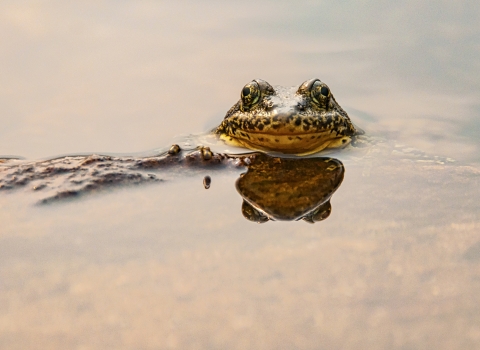This week, 166 endangered Sierra Nevada yellow-legged frogs were released into cool streams on the Plumas National Forest to improve their declining population numbers in the northern Sierra Nevada.
Native frog populations in the Sierra Nevada have been heavily impacted by chytridiomycosis, a deadly fungal disease caused by the pathogen Batrachochytrium dendrobatidis, known as ‘Bd’ or ‘chytrid’ for short. This fungus has been impacting amphibians around the world and is present in many amphibian populations throughout the Sierra Nevada.
“After initial declines, many frog populations are persisting with the disease and rebounding, while others have been decimated when the disease first appears,” said Isaac Chellman, an environmental scientist with the California Department of Fish and Wildlife.
In 2022, biologists from the U.S. Forest Service, U.S. Fish and Wildlife Service and California Department of Fish and Wildlife collected wild Sierra Nevada yellow-legged frog tadpoles living on the Plumas National Forest. The tadpoles were brought to San Francisco Zoo & Gardens and placed in an amphibian headstart program, which rears young, vulnerable tadpoles into adult frogs in captivity. This program greatly improves survival rates of the frogs in their early life stages by helping them through metamorphosis when they are particularly susceptible to chytrid.
Once the tadpoles matured into frogs, Zoo conservationists treated half of the frogs for the deadly fungal disease. The remaining frogs were left untreated so biologists can test the effectiveness of treatments on the frogs’ long-term survival.
“The hope is this treatment will help protect them from the fungus so they can continue to reproduce and repopulate the streams and lakes in this part of the Sierra,” said Jessie Bushell, Director of Conservation at San Francisco Zoo and Gardens.
This week, the frogs were returned to streams near the location where they were found as tadpoles.
“The Plumas National Forest has several streams that have deep pools that can sustain the frog through the hot summer months and provide shelter during the winter,” said Colin Dillingham, wildlife biologist at the Plumas National Forest.
Before the release, biologists worked together streamside to scan a small identification chip under each frog’s skin and take a photo of their uniquely identifying chin spot patterns. The chips and chin spot patterns will be helpful in identifying individual frogs and differentiating captive-raised frogs from those that matured in the wild.
“This effort is a great example of organizations coming together to help an endangered species recover in the wild. The Endangered Species Act turns 50 years old this year, and the recovery of listed species is dependent on the cooperation of many partners,” said Ian Vogel, senior wildlife biologist at the U.S. Fish and Wildlife Service's Sacramento Fish and Wildlife Office.
Biologists will continue to monitor the released frogs and watch for signs of the fungal disease.
There are ways you can help the amphibians, too. Vogel suggests that people clean their boots and gear regularly to prevent the spread of chytrid and other diseases. Additionally, people should avoid introducing other species, like live bait or pet bullfrogs, into creeks and streams as they can also carry disease or prey on frogs.
Frog Facts:
- The Sierra Nevada yellow-legged frog was listed as endangered on June 30, 2014.
- Threats to the frog include habitat loss and destruction due to dams and water diversions, recreation, grazing, road construction and timber harvesting; impacts of climate change climate change
Climate change includes both global warming driven by human-induced emissions of greenhouse gases and the resulting large-scale shifts in weather patterns. Though there have been previous periods of climatic change, since the mid-20th century humans have had an unprecedented impact on Earth's climate system and caused change on a global scale.
Learn more about climate change such as drought and wildfire; and the introduction of trout, bullfrogs and other non-native species that carry diseases and eat the frog. - Both adults and tadpoles overwinter for up to nine months in the bottoms of lakes, ponds and in-stream pools.








